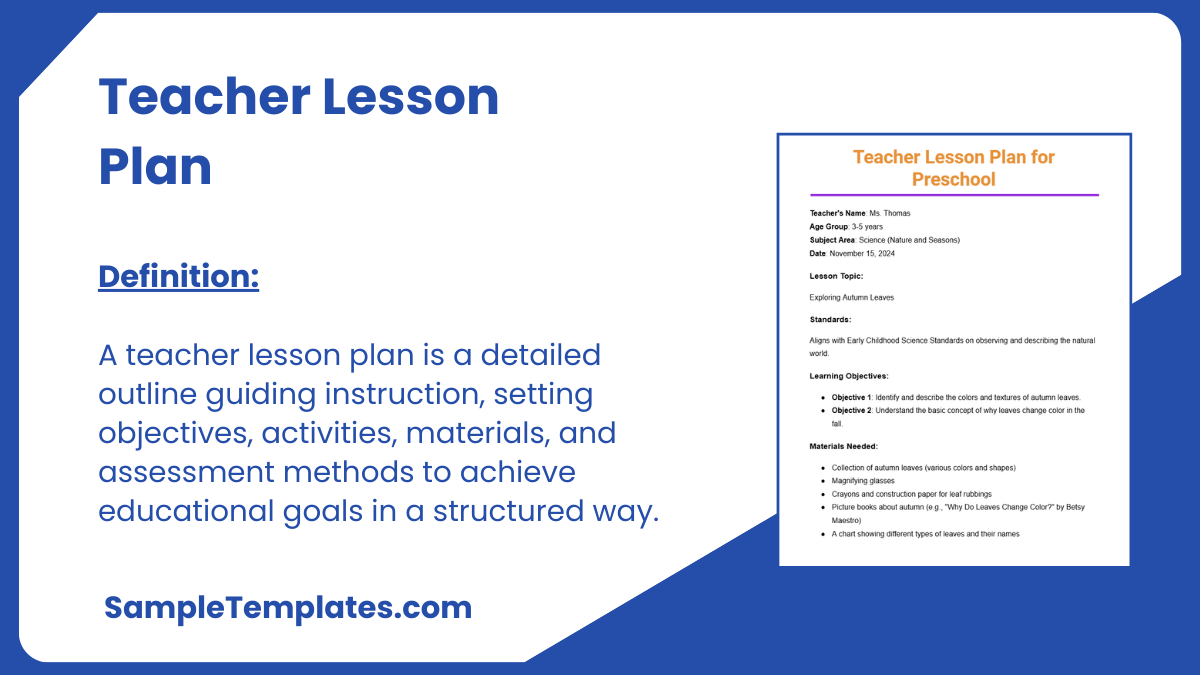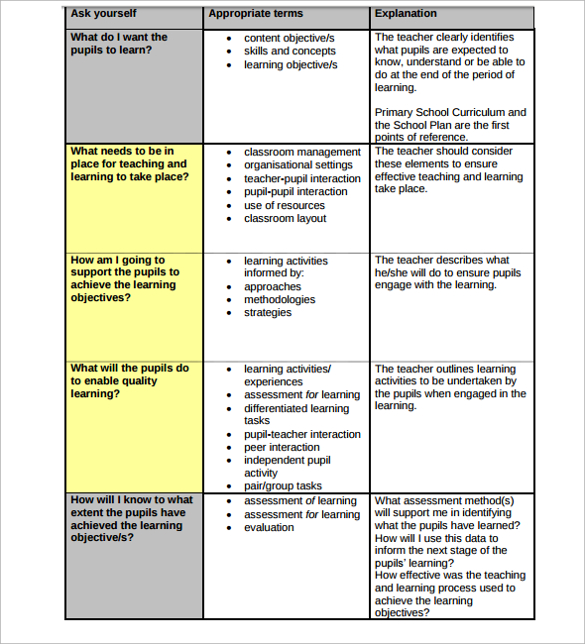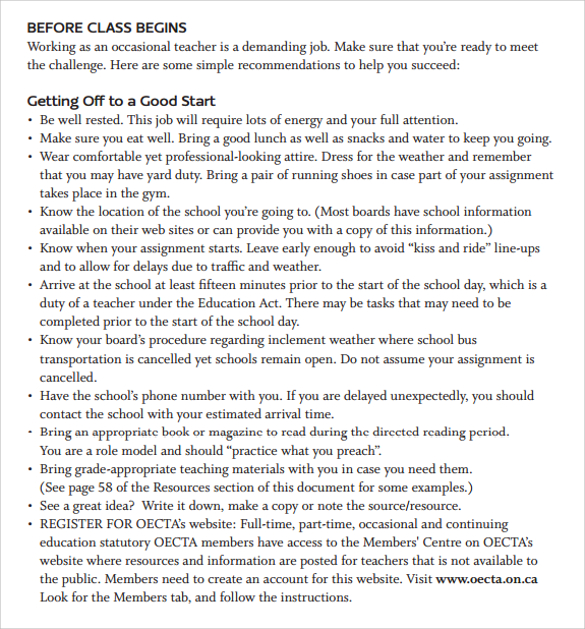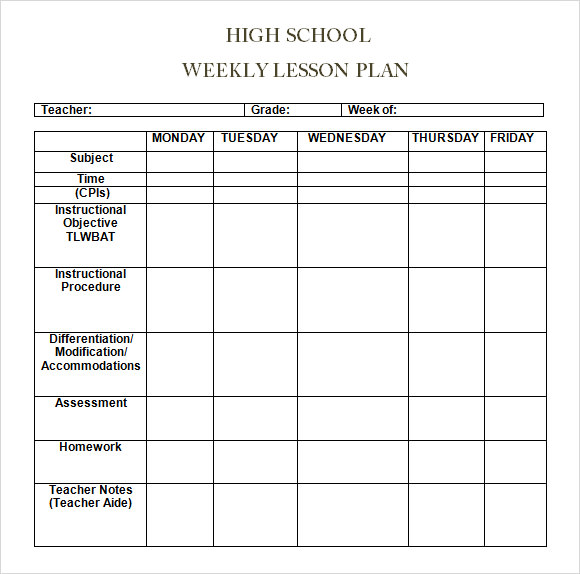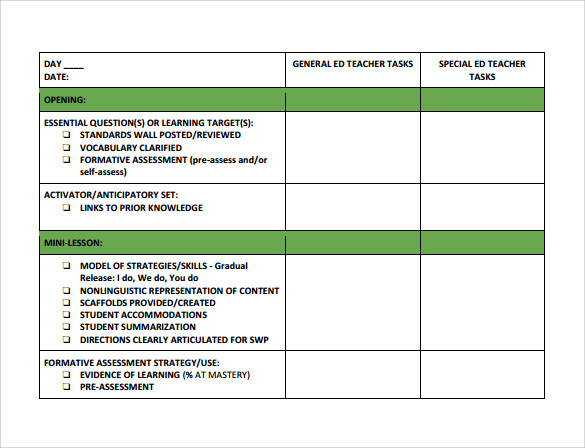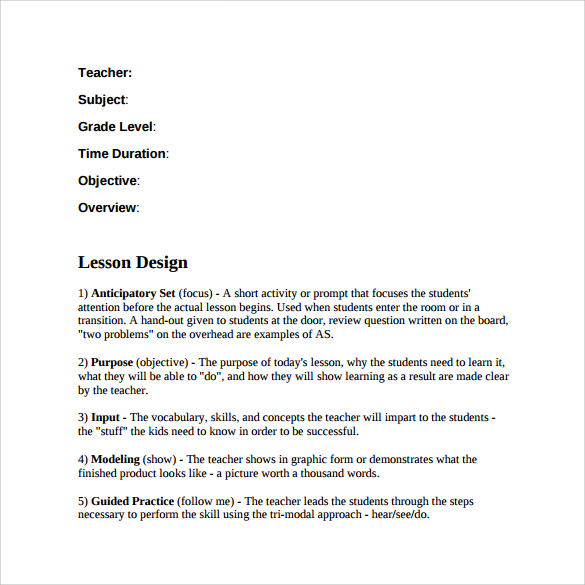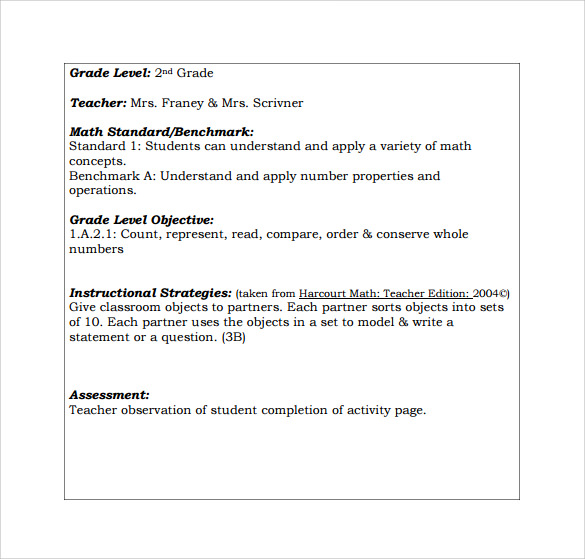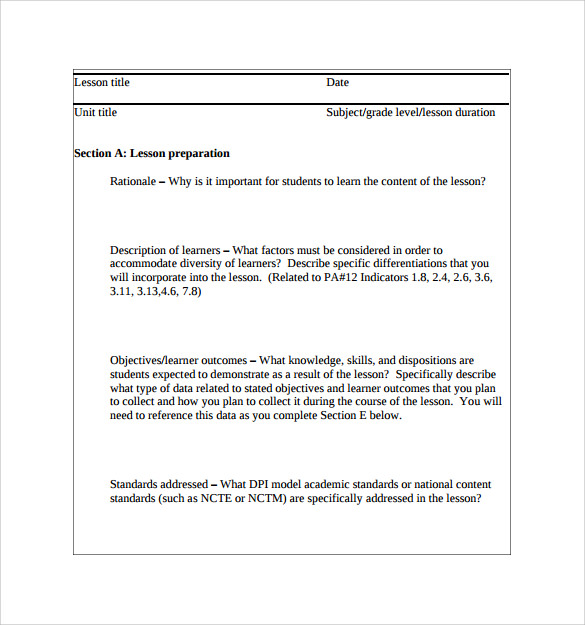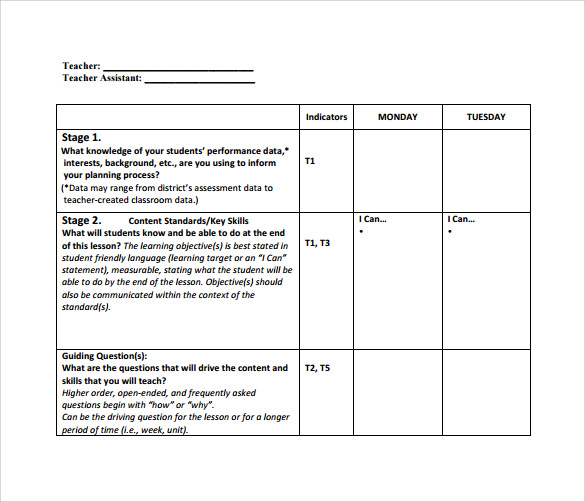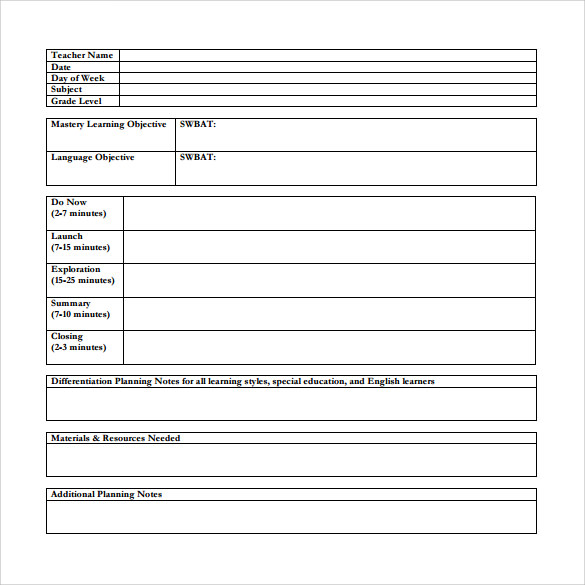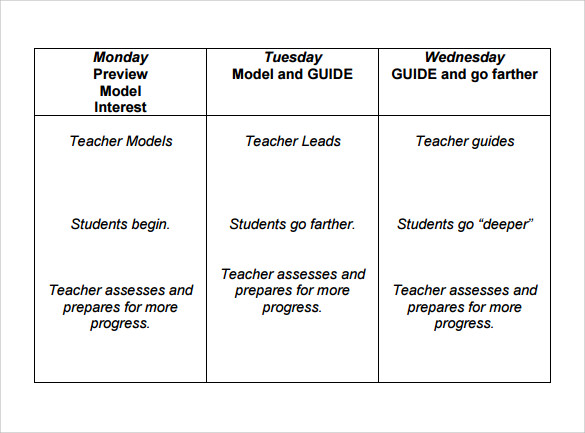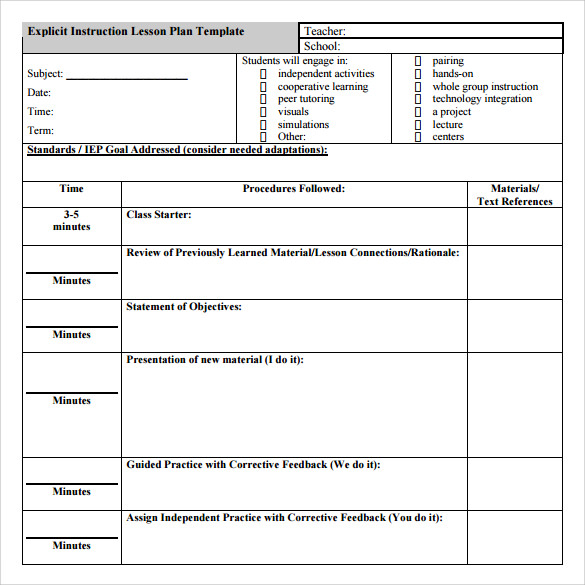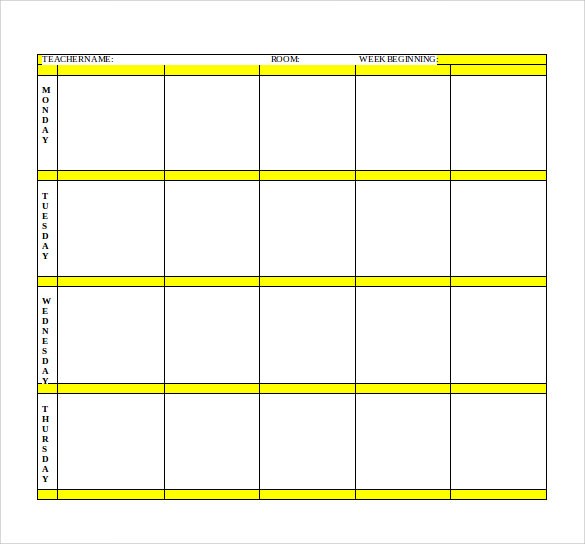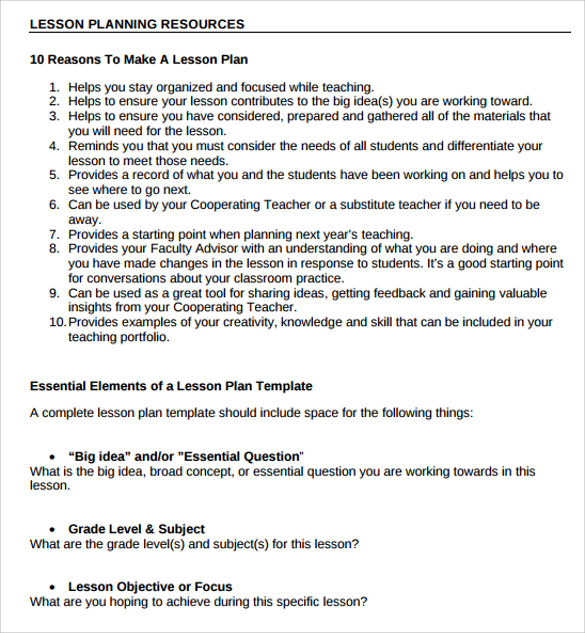Objective or the learning goal describing what the student will learn through the lesson , Time estimate on how long each lesson will take to study, Ways to support students needing extra help and extra challenges in learning the lesson, A sequence that describes what will happen during each part of the lesson and finally, An assessment, which gauges what the students have learnt at the end of the lesson. There are a number of websites, which offer short Weekly Lesson Plan Template, which will help the teacher educate her students.
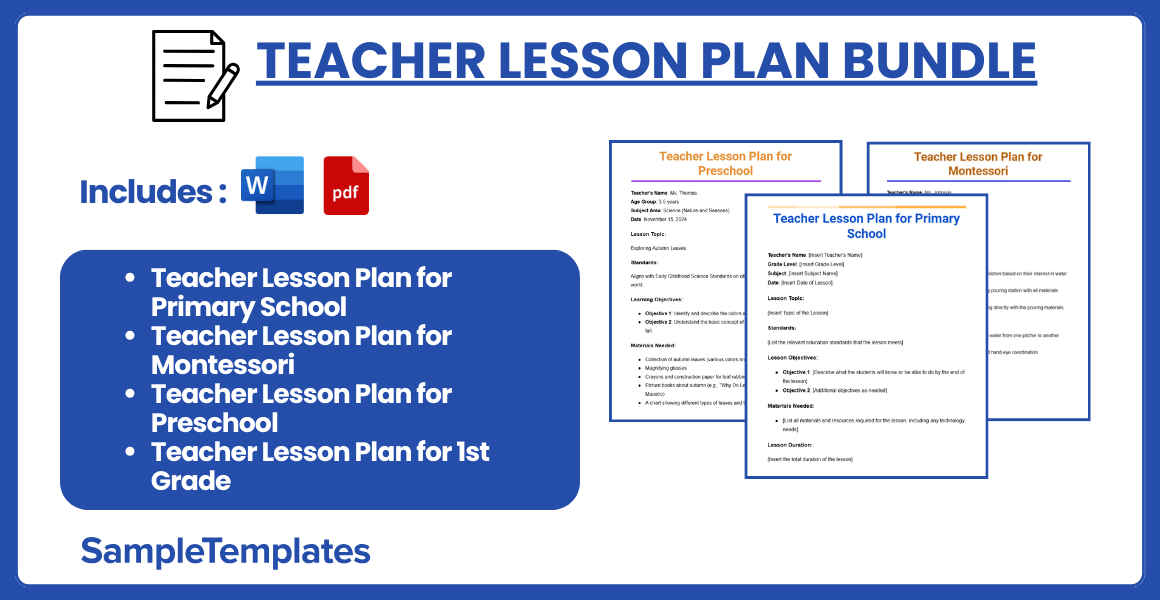
Download Teacher Lesson Plan Bundle
Teacher Lesson Plan for Primary School
Teacher’s Name: [Insert Teacher’s Name]
Grade Level: [Insert Grade Level]
Subject: [Insert Subject Name]
Date: [Insert Date of Lesson]
Lesson Topic:
[Insert Topic of the Lesson]
Standards:
[List the relevant education standards that the lesson meets]
Lesson Objectives:
- Objective 1: [Describe what the students will know or be able to do by the end of the lesson]
- Objective 2: [Additional objectives as needed]
Materials Needed:
- [List all materials and resources required for the lesson, including any technology needs]
Lesson Duration:
[Insert the total duration of the lesson]
Instructional Plan:
Introduction (5-10 minutes):
- [Describe how you will introduce the topic to engage students, possibly with a question, anecdote, or interactive activity]
Instruction (15-20 minutes):
- Step 1: [Detail the first step of the instruction, explaining the concept or skill]
- Step 2: [Next steps, ensuring each is clear and builds upon the last]
Guided Practice (10-15 minutes):
- [Describe activities where students apply what they’ve learned with the teacher’s support]
Independent Practice (10-15 minutes):
- [Activities that students can do on their own to reinforce the lesson]
Closing (5-10 minutes):
- [Summarize the lesson, reinforcing major points and objectives]
- [Plan any follow-up questions or activities for students to connect the lesson to future learning]
Assessment:
- Formative Assessment: [Describe how you will assess student understanding throughout the lesson, such as questions, quick tasks, or observations]
- Summative Assessment: [Describe any planned quizzes, assignments, or other tools to assess learning at the lesson’s end]
Differentiation Strategies:
- [Explain how you will address the needs of students with varying abilities, including extensions for advanced students and supports for those needing extra help]
Additional Notes:
- [Any further details important for the lesson or reminders for the teacher’s reference]

Teacher Lesson Plan for Montessori
Teacher’s Name: Ms. Johnson
Age Group: 3-6 years
Subject Area: Practical Life
Date: November 10, 2024
Lesson Topic:
Pouring Water
Montessori Principles:
- Follow the Child: Observe and engage children based on their interest in water activities.
- Prepared Environment: Set up an inviting pouring station with all materials within reach.
- Autoeducation: Children learn by engaging directly with the pouring materials.
Learning Objectives:
- Objective 1: Children will practice pouring water from one pitcher to another without spilling.
- Objective 2: Enhance fine motor skills and hand-eye coordination.
Materials Needed:
- Two small glass pitchers
- Water
- Sponge for cleanup
- Tray to contain spills
Activity Duration:
20-30 minutes (flexible, as children choose this activity during work cycles)
Instructional Plan:
Introduction:
- Demonstrate the pouring process slowly and clearly, using precise hand movements to show how to grip the pitchers and control the pouring.
Main Activities:
- Activity 1: Children individually practice pouring water between pitchers at a designated water activity table.
- Activity 2: Introduce colored water to mix primary colors in separate containers for advanced exploration.
Guided Discovery:
- Encourage children to discuss what happens if they pour quickly versus slowly, guiding them to discover the effects of their actions on water spillage.
Individual Work Time:
- Allow children to independently select the pouring activity among their choices for the day. They may return to the activity multiple times or extend their learning to related tasks like watering plants.
Group Activity (optional):
- Facilitate a group discussion where children share their experiences and discoveries about pouring, including any challenges they faced and how they solved them.
Observations and Notes:
- Individual Observations: Note which children show proficiency and which need more practice. Observe if children are more engaged with clear or colored water.
- Adjustments: Consider introducing funnels or different-sized pitchers if children master basic pouring quickly or show increased interest.
Assessment:
- Continuously observe and record children’s ability to control the pouring process and their problem-solving strategies during spills.
Reflection:
- Reflect on the success of the activity based on the children’s engagement and skill development. Adjust the complexity of the task or the setup based on today’s outcomes.
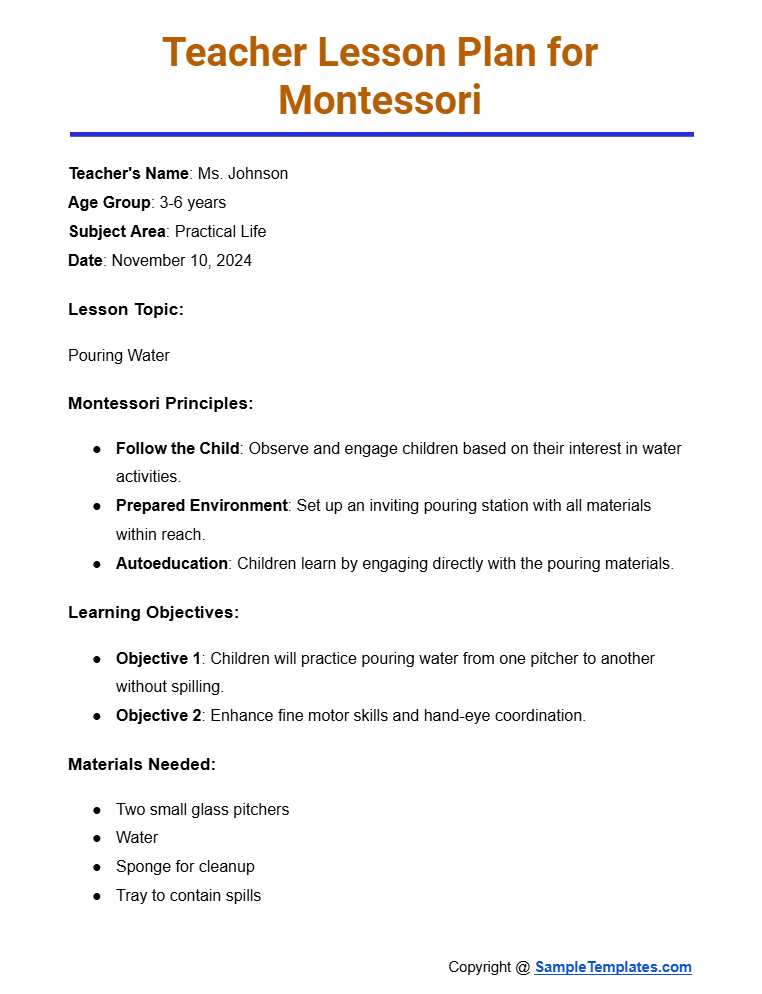
Teacher Lesson Plan for Preschool
Teacher’s Name: Ms. Thomas
Age Group: 3-5 years
Subject Area: Science (Nature and Seasons)
Date: November 15, 2024
Lesson Topic:
Exploring Autumn Leaves
Standards:
Aligns with Early Childhood Science Standards on observing and describing the natural world.
Learning Objectives:
- Objective 1: Identify and describe the colors and textures of autumn leaves.
- Objective 2: Understand the basic concept of why leaves change color in the fall.
Materials Needed:
- Collection of autumn leaves (various colors and shapes)
- Magnifying glasses
- Crayons and construction paper for leaf rubbings
- Picture books about autumn (e.g., “Why Do Leaves Change Color?” by Betsy Maestro)
- A chart showing different types of leaves and their names
Lesson Duration:
30 minutes
Instructional Plan:
Introduction (5 minutes):
- Begin with a storytime session reading “Why Do Leaves Change Color?” to introduce why leaves change color in autumn.
Instruction (10 minutes):
- Show real autumn leaves to the children and discuss the different colors and textures.
- Use the chart to point out a few common types of leaves and their names.
Guided Practice (5 minutes):
- Pass around magnifying glasses and let children explore the details of different leaves.
- Guide them to match leaves from the collection to the pictures on the chart.
Independent Practice (5 minutes):
- Provide materials for leaf rubbings. Help children place leaves under paper and rub with crayons to create a leaf print.
- Encourage children to describe the colors and textures they see and feel.
Closing (5 minutes):
- Gather the children and ask them to share one thing they learned about autumn leaves.
- Display their leaf rubbings on a bulletin board with labels of the leaf types they used.
Assessment:
- Observe children’s ability to match leaves to the correct names on the chart.
- Listen as children describe the leaves’ colors and textures during the activities.
Differentiation Strategies:
- For advanced learners, introduce simple scientific concepts about photosynthesis and how it relates to leaf color change.
- For learners who need more support, provide one-on-one guidance during the leaf rubbing activity and use simpler language when explaining the types of leaves.
Additional Notes:
- Ensure all children have a chance to participate in each activity.
- Prepare extra materials in case some children want to explore more than one type of leaf.
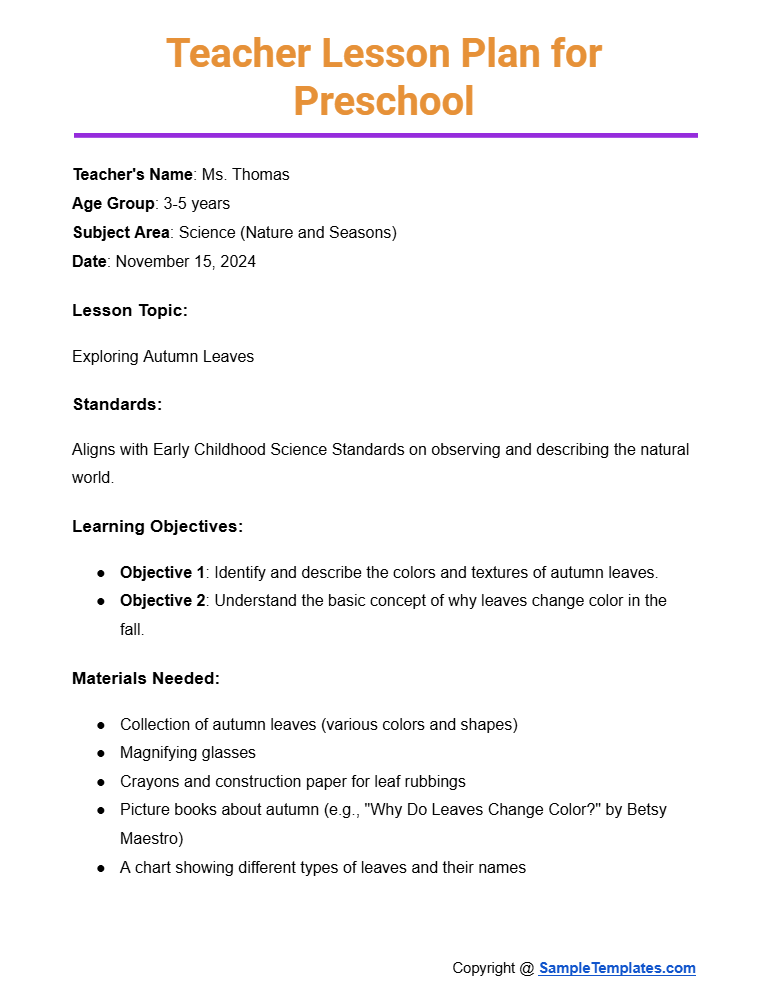
Teacher Lesson Plan for 1st Grade
Teacher’s Name: Mr. Lewis
Grade Level: 1st Grade
Subject: Mathematics
Date: November 20, 2024
Lesson Topic:
Introduction to Addition
Standards:
Aligns with Common Core State Standards for Mathematics – 1.OA.A.1 (Use addition within 20 to solve word problems involving situations of adding to, putting together, taking apart, etc.)
Learning Objectives:
- Objective 1: Understand the concept of addition as putting together and adding to.
- Objective 2: Solve addition problems within 10.
Materials Needed:
- Counting blocks
- Addition worksheets
- Whiteboard and markers
- Interactive math games (prepared on classroom tablets)
- Storybook: “Mission Addition” by Loreen Leedy
Lesson Duration:
45 minutes
Instructional Plan:
Introduction (10 minutes):
- Begin with a read-aloud of “Mission Addition” to introduce addition in a fun, relatable way.
- Discuss the book’s examples of addition in everyday scenarios.
Instruction (10 minutes):
- Explain the concept of addition using counting blocks. Demonstrate several examples on the whiteboard, e.g., 3 blocks + 2 blocks = 5 blocks.
- Engage students by asking them to participate in creating addition sentences using the blocks.
Guided Practice (10 minutes):
- Distribute addition worksheets and walk through a few problems as a class.
- Allow students to work in pairs to complete a worksheet that involves adding numbers within 10, using counting blocks to help them visualize the problems.
Independent Practice (10 minutes):
- Have students work individually on interactive math games on tablets, focusing on addition within 10.
- Circulate the room to provide support and ensure understanding.
Closing (5 minutes):
- Gather students together and ask volunteers to share one thing they learned about addition.
- Highlight good examples and correct misunderstandings as needed.
Assessment:
- Collect and review worksheets to assess understanding and accuracy of addition within 10.
- Observe student engagement and problem-solving during interactive game play.
Differentiation Strategies:
- Provide support by using number lines for students who struggle with counting.
- Challenge advanced students with word problems that involve addition within 20.
Additional Notes:
- Prepare backup activities in case the technology for interactive games fails.
- Plan to reteach this concept with different materials if the class does not grasp addition basics.

Browse More Templates On Teacher Lesson Plan
Teacher Short Lesson Plan Template
A short lesson plan template helps the teacher plan the lesson she has to teach her students. It will contain all the important points that need to be covered in the lesson. Having such a template assists the teacher in covering everything present in the lesson. Therefore, a short lesson plan template is a proforma plan to teach the lesson.
Teacher’s Day Lesson Plan Template
A teacher day plan template covers the plan the teacher needs to follow during the day while she is in school. This plan lays down a teaching plan for the teacher. It also helps remind her about the important things she needs to teach her students. Thus, a teacher day plan template can be likened to a teacher’s daily schedule.
Weekly Teacher Lesson Plan Template
A weekly lesson plan template just like a day plan template gives the teacher an idea about what she has to teach when during the week. In case there are some important points to cover in the lesson, the weekly lesson plan also helps remember her schedule during the week.
Teacher Lesson Plan Template Sample
How to Write a Teacher Lesson Plan?
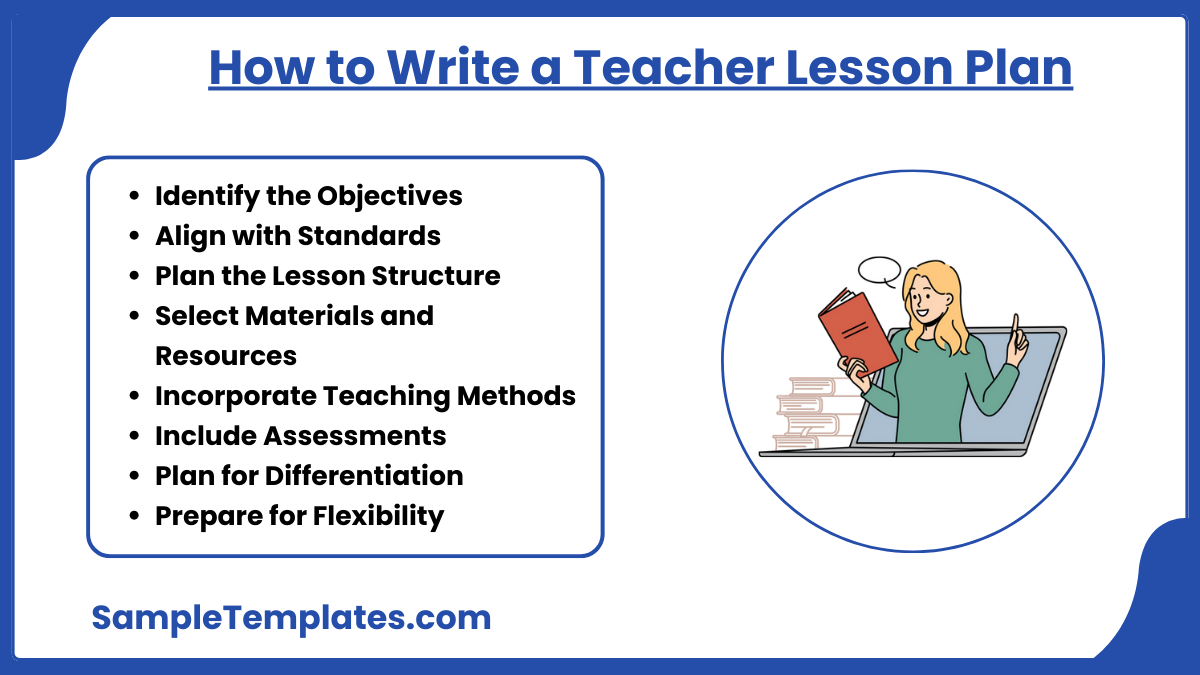
- Identify the Objectives:
- Clearly define what students should know or be able to do by the end of the lesson. Objectives should be specific, measurable, attainable, relevant, and time-bound (SMART). You can also see more on Blank Lesson Plan.
- Align with Standards:
- Ensure the lesson aligns with district, state, or national educational standards. This alignment helps maintain consistency and ensures the educational goals are met.
- Plan the Lesson Structure:
- Break down the lesson into distinct sections, such as introduction, instruction, guided practice, independent practice, and closure. This structure helps in delivering the content effectively and managing classroom time.
- Select Materials and Resources:
- List all the materials and resources needed for the lesson, including books, handouts, technology tools, and any other supplies. Ensure all materials support the learning objectives and are ready before the lesson begins.
- Incorporate Teaching Methods:
- Decide on the teaching methods and strategies to use, such as lectures, discussions, hands-on activities, or technology integration. Choose methods that cater to various learning styles and student needs.
- Include Assessments:
- Plan how to assess students’ understanding throughout and at the end of the lesson. Consider using formative assessments like quizzes, class discussions, or exit tickets, and summative assessments if applicable. You can also see more on Curriculum Lesson Plan.
- Plan for Differentiation:
- Prepare strategies to accommodate students with different learning needs and levels. This could include adapting materials, using varied instructional strategies, or offering additional challenges and supports.
- Prepare for Flexibility:
- While a detailed plan is crucial, be prepared to adapt based on student responses and engagement. Have backup activities or extensions ready in case they are needed.
Simple Teacher Lesson Plan Template
Daily Teacher Lesson Plan Template
Basic Teacher Lesson Plan Template
Teacher Lesson Plan Assessment Template
Importance of Lesson Plan
- Provides Structure and Direction:
- Lesson plans serve as a roadmap for the teacher, offering a structured approach to the class session. They ensure that the teacher knows exactly what needs to be covered and how to guide the lesson effectively from start to finish, maintaining a clear focus throughout the class. You can also see more on Lesson Planning.
- Enhances Teacher Confidence and Efficiency:
- Knowing the lesson’s structure in advance helps teachers feel more confident and organized. This preparation allows them to manage classroom time more efficiently, ensuring that all necessary material is covered without unnecessary digressions.
- Supports Objective-Based Learning:
- Lesson plans are designed with specific learning objectives in mind, which are aligned with broader educational standards. This ensures that each lesson contributes to the students’ long-term educational goals, focusing on both knowledge acquisition and skill development.
- Facilitates Assessment and Feedback:
- Planned lessons include strategies for assessing student understanding through both formative and summative assessments. This allows teachers to provide immediate feedback and make real-time adjustments to teaching strategies, enhancing student learning outcomes. You can also see more on Yearly Lesson Plan.
- Promotes Consistency and Accountability:
- Lesson plans create a consistent framework for both teachers and students. For teachers, they provide a record of what has been taught and serve as a point of accountability for covering all necessary content. For students, this consistency helps them know what to expect and understand the learning process more clearly.
- Enables Effective Differentiation:
- Detailed lesson plans allow teachers to anticipate and incorporate different teaching methods and materials that cater to diverse learning styles and needs within the classroom. This tailored approach helps to ensure that all students can engage with the lesson effectively, regardless of their individual learning abilities.
Standard Teacher Lesson Plan Template
Teacher Lesson Plan Template Kindergarten
Teacher Lesson Plan Template Example
Assistant Teacher Lesson Plan Template
Benefits of Lesson Plan

- Enhances Learning Outcomes:
- Well-structured lesson plans align activities and materials directly with learning objectives, ensuring that students gain the intended knowledge and skills. This strategic alignment improves learning outcomes by clearly defining what success looks like for each lesson. You can also see more on Lesson Plan Objective.
- Increases Classroom Engagement:
- Lesson plans help teachers prepare diverse and dynamic activities that can cater to various learning styles. This variety keeps students engaged and motivated, making learning more interactive and enjoyable, which enhances retention and understanding.
- Promotes Efficient Use of Classroom Time:
- A detailed lesson plan guides the teacher through each phase of the class, from introduction to conclusion, ensuring that time is managed effectively. This prevents overruns and underutilized time, maximizing the educational value of each session.
- Supports Student Independence:
- By outlining clear objectives and expectations, lesson plans help students understand what is expected of them and how they can achieve these goals. This clarity supports independent learning and encourages students to take responsibility for their own educational progress. You can also see more on Lesson Plan Outline.
- Facilitates Professional Development:
- The process of lesson planning requires teachers to reflect on their teaching strategies and continually adapt and improve them. This ongoing reflection and adaptation contribute to professional growth and development, helping teachers become more effective educators.
- Ensures Continuity in Learning:
- Lesson plans document the learning journey across days, weeks, and months, providing a roadmap that ensures continuity. This continuity is crucial when multiple teachers are involved, or when tracking progress over longer periods, as it ensures that all necessary content is covered and that learning builds progressively. You can also see more on Elementary Lesson Plan.
Teacher Lesson Planning Template
Teacher Common Lesson Plan Template
Teacher Universal Lesson Plan Template
Example of Teacher Lesson Plan Template
Teacher Instruction Lesson Plan Template
Teacher’s Weekly Lesson Plan Template
Teacher Lesson Plan Resource Template
Advantages of Lesson Plan
Some advantages of lesson planning are that it inspires the teacher to better her teaching techniques, helps the teacher in evaluating her teaching, develops an uncanny self confidence in the teacher, a plan inspires the teacher to ask proper and probing questions which will adequately test her pupils.
Uses and Purpose of Sample Teacher Lesson Plan Template
Writing lesson plans before taking a lecture is the mark of a good teacher. A lesson plan helps the teacher decide the type of content to be included in the lesson. Additionally, it also tells her the method of instruction she needs to follow so that all her students will understand what she is teaching. It helps a teacher do time management during her lecture. The lesson plan will be a guide and a pathway for the teacher to organize her teaching materials and administer them properly. A lesson plan fulfills the purpose of fulfilling the goal of making the students understand what is being taught by the teacher. You can also see more on Trainer Lesson Plan.
Target Audience for Sample Teacher Lesson Plan
The main audience for a lesson plan is the teacher herself. Apart from that, the students can also be included as audience. Writing an effective lesson plan is an art and once the lesson plan is written correctly then the goal of making every student understand the lesson will be achieved. A lesson plan helps the teacher organize her teaching material in such a way that she can impart the right kind of knowledge to her students. Therefore, a lesson plan is the most important document of a lesson. A lesson plan is as effective as the effectiveness of the teacher writing it.
Benefits of Sample Teacher Lesson Plan
A teacher day plan template gives lessons that are well planned in advanced are more likely to assist the student learning process. They are also more likely to fulfill the goals of teaching the lesson i.e. imparting knowledge to the students. A Unit Lesson Plan Templates also helps the teacher stay on track while she is teaching a lesson. Lesson planning helps the teacher visualize and therefore plan each step of the learning process. This visualization is mainly responsible for the teachers success. A well-made lesson plan will also help some other substitute teacher to impart the same knowledge if you cannot be present during the class for some reason or the other.
Thus, we have seen the uses, purpose and benefits of a Daily Lesson Plan Template format and also studied some important features of a weekly lesson plan template. This article does not promise to be an exhaustive document on the subject of lesson plan but it covers most of the preliminary knowledge there is to know about five minute lesson plan online.
If you have any DMCA issues on this post, please contact us!
Related Posts
Weekly Schedule Samples & Templates
Contractual Agreement Samples & Templates
FREE 9+ Amazing Sample Church Bulletin Templates in PSD | PDF
Sample Business Card Templates
Sample Cashier Job Descriptions
Questionnaire Samples
FREE 10+ Sample HR Resource Templates in PDF
FREE 49+ Sample Job Descriptions in PDF | MS Word
FREE 16+ Nonprofit Budget Samples in PDF | MS Word | Excel | Google Docs | Google Sheets | Numbers | Pages
FREE 13+ Academic Calendar Templates in Google Docs | MS Word | Pages | PDF
FREE 10+ How to Create an Executive Summary Samples in Google Docs | MS Word | Pages | PDF
FREE 23+ Sample Event Calendar Templates in PDF | MS Word | Google Docs | Apple Pages
Company Profile Samples
FREE 10+ Leadership Report Samples [ Development, Training, Camp ]
FREE 24+ Sample Payment Schedules in PDF | MS Word
